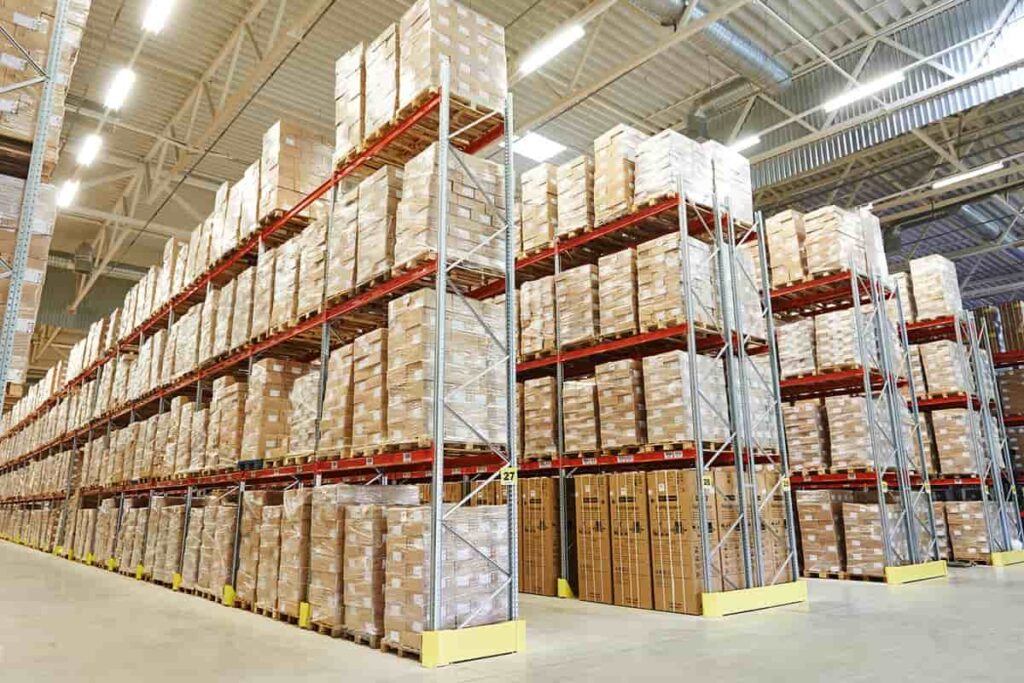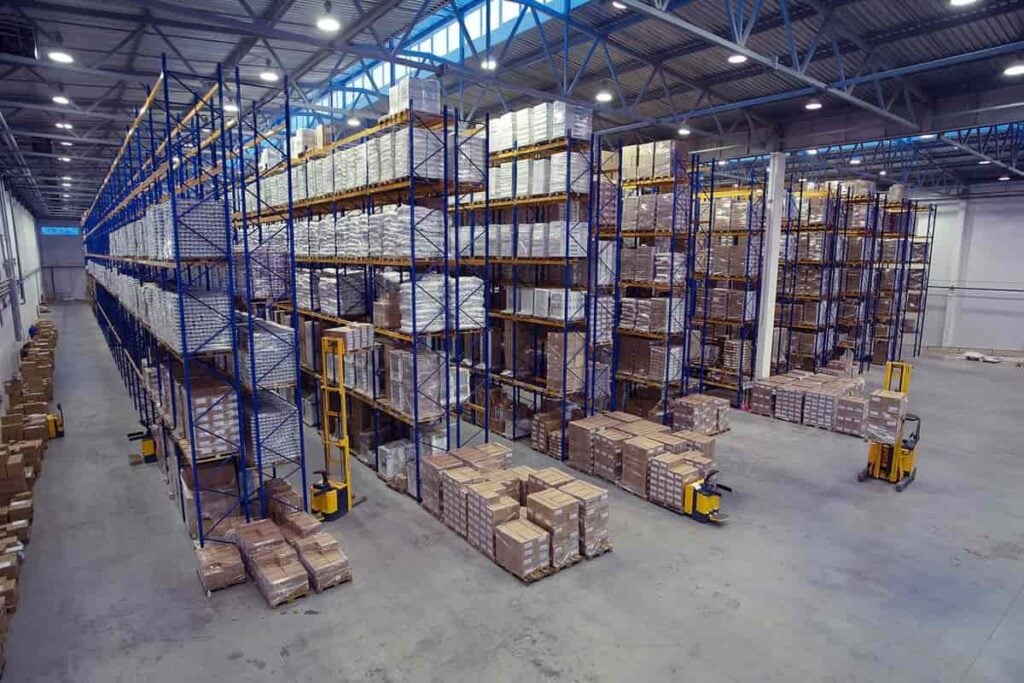Flying Drones For Better Warehouse Management
Table of contents

Almost exactly one year ago, our MBAs were doing field research at cannabis dispensaries in the Pacific Northwest and looking into “How Fruit Packing Warehouses Use Technology.” In the small town of Bingen, Washington, there’s a new fruit packing warehouse that transformed its entire operation using automation and robotics. They’re just one of more than 18,700 warehouses scattered across the United States that are turning to technology to do things better, cheaper, and quicker.
In a recent article, we talked about how drones may soon be delivering packages, so we better teach them how to do inventory too. That’s what a startup called Ware is doing.
Drones for Warehouse Management
Founded in 2019, San Francisco startup Ware has taken in $2.5 million in seed funding to develop a warehouse inventory automation platform that uses drones, the Skydio 2 to be specific. These are built by another drone startup we looked at recently, Skydio, whose product is apparently so good that an entire company can be built around it. The new Skydio 2 sports six 4K navigation cameras for 360° obstacle avoidance and the NVIDIA TX2, a supercomputer-on-a-module for edge computing, that enables the aircraft to react on the fly.

About a year ago, Ware CEO Ian Smith was interviewed on the Drone Radio Show podcast where he talked about how their solution was “drone provider agnostic,” but then went on to say that mainly refers to DJI and Skydio. While Ware started with DJI drones, they’re largely working with Skydio, and their website seems to reflect that’s the direction they’re taking. Given all the work Skydio has put into developing software for autonomous drone navigation, why duplicate their efforts?
Hardware aside, the Ware product has three main components to it:
- Data Collection – Drone flies autonomously and captures all the data on bin locations, then returns to nest and uploads to the cloud.
- Data Processing – Data is processed using Ware’s machine learning algorithms
- Report Delivery – What it says on the tin
As for the drones, they all have nests where they live, recharging themselves automatically so that no human intervention is needed for them to fly around collecting data. Let’s talk about the primary use case for Ware’s solution, counting inventory.
Drones Counting Inventory
Most warehouses and distribution centers strive for twice-yearly or quarterly full-counts of their inventory, but because of labor challenges and competing priorities, many don’t reach those goals. There’s also cycle counting, a more frequent inventory management activity where a small sample of inventory is counted as opposed to the entire population of inventory.
Using drones to count inventory has only become a reality in the past few years because of drones like the Skydio 2 that can safely operate indoors without GPS signals. Because they fly indoors, Ware’s drones don’t have to worry about regulations like beyond visual line of sight (BVLOS), better known as Part 135 certification, in the United States. To prove that the inventory counting use case is economically viable, Ware deployed their solution in several warehouses belonging to two top-twenty third-party logistics providers. Here are the key metrics used in the study:
- Accuracy – How accurate the inventory counts are. Humans make mistakes.
- Number of full inventory counts – As we said earlier, most warehouses only do full inventory counts twice a year.
- Lost inventory – Believe it or not, warehouses actually allocate a budget for lost inventory every year.
- Headcount – The number of humans you need on your inventory team.
The most notable improvements come from the speed at which these drones can operate. A team of humans, on average, covers 13 bins per hour. Each Ware drone can cover 75 bins per hour (in Nests) and 300 bins per hour (with human battery swaps). This means you can do 13X more complete inventory counts a year by using drones. Here are the results of the case study which pitted human against machine for a true apples-to-apples comparison:

The total savings from Ware are about split between headcount reduction and inventory that didn’t end up getting lost. In case you can’t read the fine print, facilities will achieve a full return on their investment for a Ware deployment in 4 to 6 months. After that, those savings will directly affect the bottom line. Companies can also consider other benefits such as reduced liability and limits on wear-and-tear that cycle counting imposes on lifts.
With such a compelling value proposition, it’s no surprise that other entrepreneurs are throwing their hats into the autonomous drone warehouse management ring,
FlytBase, FlytNow, and FlytWare
Founded in 2017, San Francisco startup FlytBase has taken in an undisclosed amount of funding to develop “an enterprise drone automation platform which provides drone agnostic software solutions to deploy fully automated & cloud-connected commercial drones at scale.” They’ve named that solution FlytNow, and already have 12,000 users on the platform across 100 countries with over 100 solutions delivered. One of those is FlytWare, an autonomous drone solution for warehouse management.
In a YouTube video that looks at a FlytWare deployment in IAG Cargo’s Madrid facility, they appear to be using DJI drones, but the company doesn’t acknowledge this in their FAQ simply stating “FlytWare is designed to be hardware agnostic – it can easily be migrated to another drone model from the same vendor, as well as to drones with similar capabilities from another vendor.”
Similar to Ware, FlytBase also piloted their solution with several large freight companies. IAG Cargo handles freight capacity for passenger flights frequenting 350 different destinations. FlytWare’s solution was piloted in their Madrid Hub in at least two separate trials, but no specifics were given as to the benefits realized. Romark Logistics was another company that piloted FlytBase after exploring other options such as manually flown drones, RFID tags, and ground robots with barcode scanners. That pilot was deployed in early 2020 with the expectation that FlytWare would be “production-ready in the coming weeks.”
FlytBase vs. Ware
In looking at the FlytBase technology stack, it appears they’ve built the entire platform from the ground up to be drone agnostic (they don’t mention Skydio as a drone provider they support, however). This makes one wonder which business model is more desirable:
- Developing everything in house – requires a great deal of resources but removes overreliance on third-party drone vendor.
- Partner with Skydio – let Skydio do what they do best – drone automation – and focus on the data interpretation and reporting
Remember, Skydio just took in $100 million which they’re using to further build out and expand their platform, which contains a great deal of off-the-shelf automation capabilities. If much of the autonomous functionality is already built, then it’s easier to focus on additional warehouse management use cases. On the other hand, FlytBase has to manage the development of their entire technology stack – the Internet of Devices as they call it – which is being engineered to address other industry verticals such as emergency response, remote inspections, and security operations.
Other Companies Using Flying Drones in Warehouses
Ware and FlytBase aren’t the only companies applying autonomous drone technology to warehouse inventory applications. In our piece on 10 AgTech Startups for Agriculture in Africa, we looked at a South African startup called DroneScan that’s using a variety of form factors – including flying drones – for inventory counting. Chicago startup Corvus Robotics claims to have developed the world’s first unmanned warehouse inventory drones, but they appear to be doing a “pandemic pivot” into disinfection robots and delivery robots. GEODIS, one of the key players in the contract logistics market worldwide, was working with Delta Drone on a solution back in 2016, though the GEODIS Countbot they released earlier this year uses wheels. Consulting firm Hardis Group has an offering called EyeSee. Finally, international technology group Körber has developed a drone inventory solution called the Doks Inventory system.
This isn’t meant to be an exhaustive list of all companies working in this space. If we missed your sacred cow, just drop us a note in the comments section below. We’re particularly interested to hear from any companies that are exploring how to integrate blockchain-enabled smart contracts into their solution. This past spring we looked at 5 Real-World Use Cases for Blockchain in Supply Chains, noting how smart contracts might be used to increase supply chain transparency. Startups like Data Gumbo are starting to see success with smart contracts, and it’s easy to envision supply chains of tomorrow using them as well.
Conclusion
Drone technology has evolved enough so that today’s drone can now operate autonomously indoors using machine vision instead of GPS. An entire host of use cases opens up with inventory management clearly being the low-hanging fruit. Ware seems to be in a better position to accelerate the number of use cases they offer warehouse managers, while FlytBase is engaging in other verticals outside of just warehouse management. There’s certainly enough room for everyone in the global trillion-dollar industry of warehousing and storage.
Sign up to our newsletter to get more of our great research delivered straight to your inbox!
Nanalyze Weekly includes useful insights written by our team of underpaid MBAs, research on new disruptive technology stocks flying under the radar, and summaries of our recent research. Always 100% free.

















Please contact me to set up a meeting to discuss your technology further
You’ll need to reach out to the company directly! We’re just a bunch of MBAs sitting around in our underwear researching technologies.